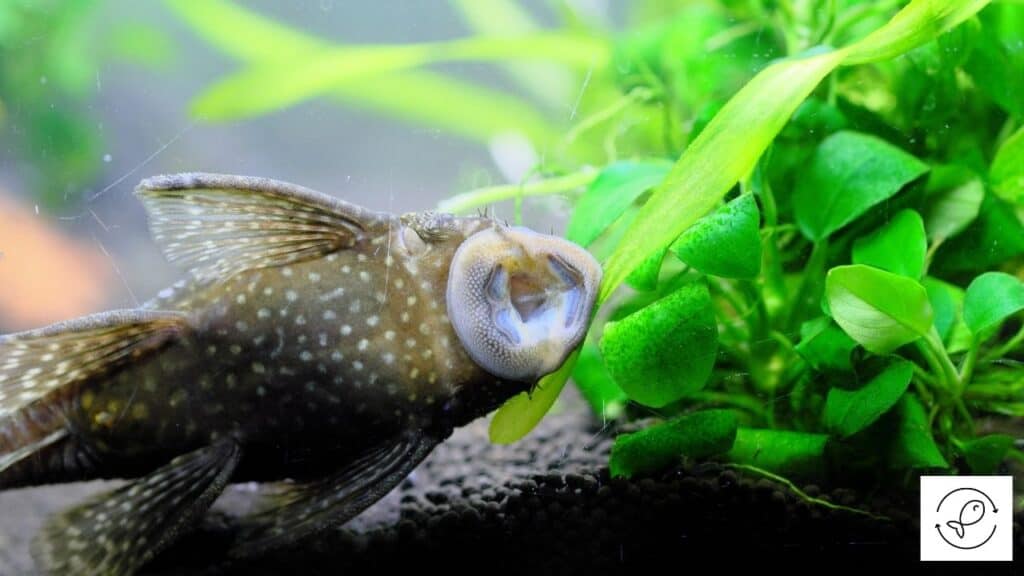Plecos have strong teeth that are designed to scrape off algae and food particles from any surface like rocks, substrate, etc. Plecos are most unlikely to bite humans. However, they will bite other plecos and fish to defend their territory while protecting the eggs and fry.
Let’s now understand whether all types of plecos have teeth.
Do All Types Of Plecos Have Teeth?
Most plecos are primarily herbivorous but are technically considered omnivorous because they do require some proteins in their diet.
So based on the dietary requirements, plecos have teeth arranged in various patterns around their mouths in the center of their sucking lips.
Depending on the type of food they eat and its availability, plecos can have different kinds of teeth.
The herbivore plecos that depend on algae and plant matter have fine teeth.
In contrast, omnivores have broad teeth structure, and carnivores have hooked teeth.
Plecos living in lakes, ponds, or swamps, where they primarily feed on wood, have teeth shaped like a spatula.
Plecos have teeth to scrape plant matter off the rocks and substrates, but they’re also seen scavenging on decaying fish.
Do Plecos Bite?
Plecos usually don’t bite.
However, they can get territorial if their tankmates invade their turf or during the mating season when their instinct is to protect their young from predators or intruders.
The male plecos can chase and nip the intruders during such a confrontation to drive them away from their territory.
This behavior is more common among larger plecos.
Plecos can also get aggressive toward other fish when they feel threatened.
Most of the time, though, plecos prefer to swim away or dive into caves or crevices when stressed out.
Why Do Plecos Bite?
In general, plecos display compatible behavior under favorable aquatic conditions.
They’re community fish and can live together peacefully with many fish of similar temperament.
But plecos aren’t always peaceful. They may show signs of aggression at times.
Given below are the reasons plecos become aggressive and bite other fish in the tank.
1. Male Plecos Are Kept Together
Plecos are peaceful when kept with different species in a community tank.
Young male plecos can also co-exist in the same tank.
However, male plecos can’t tolerate one another once they grow up and become highly territorial.
They will bite and chase each other for territory and dominance when kept in the same aquarium.
Their confrontations can turn physical and continue until one of the males gets seriously injured.
2. Food Scarcity
Food scarcity is another primary reason for aggression and biting among plecos.
They can become hostile and aggressive when hungry or underfed.
Competition for food can lead to stress in plecos, resulting in increased aggression.
Fighting and biting other tankmates during feeding time is an indication of insufficient food supply for all the fish living in the tank.
3. Stress
Stress is also the primary reason for plecos becoming aggressive.
If the fish display any signs of aggression, including biting, fin nipping, or chasing other fish, they can suffer from stress.
Stressful conditions can get created due to overcrowding, poor water conditions, inadequate lighting, low oxygen levels, high levels of ammonia, sudden or drastic changes in water conditions, and constant bullying.
Some signs of stress in plecos are loss of appetite, increased anxiety, hiding behind plants or decorations, swimming erratically, or crashing on the aquarium’s glass walls.
4. Overcrowding
Plecos need plenty of room in their tanks. So once they reach maturity, plecos don’t like to share space with their fellow tankmates.
Lack of space can restrict their freedom of movement and cause irritation, leading to aggression, biting, and nipping at each other.
Overcrowding a tank also leads to lower oxygen levels, which then increases stress.
Territorial disputes can occur when other fish intrude into plecos’ territory due to lack of space.
5. Breeding
Plecos can become territorial during breeding.
After the male pleco fertilizes the eggs, he becomes protective of them and guards them against other tankmates.
Unlike some fish that feed on their own eggs, plecos are known for their parental instincts.
Male plecos, in particular, are highly protective of their eggs and will defend them by chasing and biting the intruders.
They also keep their eggs safe from tankmates that try to eat them.
6. Illness
Illness is another cause of pleco aggression. When a fish is sick, it often gets aggressive when it usually isn’t.
To determine whether your pleco is sick, observe its behavior.
It will show signs such as lethargy, appetite loss, erratic movements, loss in coloration, bloating, attacks on other fish, etc.
How To Avoid Plecos From Biting Other Fish?
Plecos are considered peaceful fish. But certain conditions can stress them and make them aggressive.
However, you can create an environment that keeps the plecos stress-free and happy.
Given below are various ways to stop plecos from biting other fish.
1. Don’t Keep Male Plecos Together
Young male plecos of the same species can co-exist in the same tank. However, adult males will most likely fight each other.
So it’s best not to keep males plecos together.
In contrast, you can keep multiple female plecos together so that a single female doesn’t feel stressed.
2. Provide Adequate Food
Plecos are opportunistic scavengers and will eat whatever they come across.
So you must provide plecos adequate feeding opportunities to ensure they remain healthy and happy.
3. Avoid Overcrowding

Plecos need lots of space in their tanks.
Because of this, when plecos reach adulthood, they don’t like to share their space with fellow tankmates.
So you must ensure that plecos have enough space to swim and move around the tank.
Once the fish get the required space, they will remain peacefully with other tankmates.
4. Avoid Bottom Dwellers
Plecos are bottom dwellers and mostly don’t care about what’s happening above them.
However, avoid keeping other bottom-dwelling fish as they can intrude into plecos’ territory.
In addition, don’t keep bottom-feeders faster than the plecos as they can leave plecos hungry and stressed.
5. Have A Separate Tank For Breeding
Breeding most species of plecos isn’t a significant challenge in large aquariums.
However, if the plecos are kept in a community aquarium with other tankmates, they can feel stressed and vigorously protect their eggs or young ones.
So keep the pleco pair in a separate tank while breeding to ensure they aren’t disturbed or stressed by other fish.
6. Add Hiding Spots
Plecos are shy fish and can get stressed easily.
Adding caves, live plants, rocks, driftwood, etc., will create hiding spots.
Such spots will provide the plecos shelter and help them to de-stress.
7. Quarantine The Sick Fish
In general, most fish species become aggressive when they’re suffering from infections.
So it’s best to move them to another tank for treatment.
Quarantining the plecos in a separate tank will help them to calm down and recover from the ailment.
Related Questions
Do Bristlenose Plecos Have Teeth?
Yes, bristlenose plecos have teeth.
Their teeth are strong and designed to snack on driftwood and scrape algae from the bottom of the tank or off the rocks.
Like most plecos, bristlenose plecos don’t have sharp teeth to use in a territorial conflict.
Do Zebra Plecos Have Teeth?
Zebra plecos have a small suckermouth with lots of teeth.
They have seven or eight long, bent, and forked teeth on either side of their upper jaw and four deeply forked teeth on either side of their lower jaw.
As omnivores, their teeth are designed to easily slice meat and plant-based food.
Do Clown Plecos Have Teeth?
Yes, clown plecos have spoon-shaped teeth. It means their teeth are wider at the tip than the base.
These fish are omnivores with teeth designed to eat meat and plant matter.
Their teeth can easily slice a piece of wood and occasionally scrape algae and bio-film off the tank surface.

